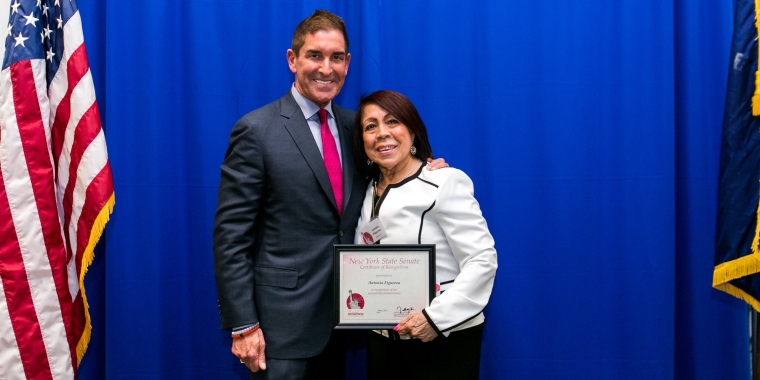
Rx: Take With Food, Water, And Caution
Jeffrey D. Klein
July 12, 2008
Klein Releases Report on the Magnitude of Dispensing Errors at New York Pharmacies 210,000 Projected Errors at New York Pharmacies
NEW YORK-Standing outside a Rite Aid which has incurred numerous citations for errors in prescription drug dispensing, Senator Jeff Klein (D-Bronx/Westchester) released a report, . The report was compiled with the assistance of United States Pharmacopeia (USP) the official public standards-setting authority for all prescription and over-the-counter medicines, and the New York State Board of Pharmacy. The report also includes original data from 400 Bronx seniors on various dispensing errors.Klein's report revealed the multitude of such errors occurring at pharmacies in New York. In 2006 alone, there were over 210 million prescriptions filled in New York by 4,700 retail pharmacists. Of those prescriptions, Klein's office calculated that based on national studies of prescription error rates, a projected 210,000 were in error with serious health threatening consequences.
"In a pharmacist's work there can be no room for error. One small type-o can seriously conflict with a patient's care or even cause death. Because dispensing errors are so drastically under-reported, we can only assume the considerable magnitude of the actual number for a state as large as New York," said Senator Klein
Only a small fraction of overall retail prescription drug dispensing errors in New York surface through The Office of Professions in the New York State Education Department (NYSED), which investigates allegations of misconduct of many professions, including pharmacists. Klein's office analyzed complaints to the New York State Office of Professions between 2005 and 2007 regarding dispensing errors and the dispensing process, as well as disciplinary actions taken by the Office.
In New York state there were only 1,275 complaints related to the prescription drug dispensing process made between 2005 and 2007.
Of the total reported errors 435 were for negligence / incompetence, 350 indicated that the wrong prescription had been filled, 210 pharmacists were reported to be practicing fraudulently, 79 indicated that the wrong quantity of medication was dispensed, 59 indicated a lack of a pharmacists on duty, 46 reported a failure to provide supervision, 43 indicated a failure to notify the pharmacy board of a change of supervisor, 36 reported a labeling mistake, and 17 reported the aiding or abetting an unlicensed person to dispense drugs.
However, just 106 formal Regents disciplinary actions (the highest level of disciplinary action) related to prescription drug process were taken from 2005 to 2007, mostly for mislabeling or misbranding medications.
"Senator Klein is to be commended for focusing attention on errors in filling prescriptions in retail pharmacies. Patients walk away from their doctors office with one or more prescriptions on average two out of every three visits. Not only are the number of fills increasing, and therefore the opportunities for dispensing errors, but the complexity and potential toxicity of drug regimens prescribed patients in their communities puts them at even higher risk. Greater oversight of retail pharmacies, encouraging e prescribing, creating public awareness about the complaint process and raising standards for pharmacy technicians are all sound suggestions for protecting New Yorkers from avoidable harm," said Arthur Levin, Director of the Center for Medical Consumers, a New York City based consumer advocacy not for profit organization.
The typical pharmacy fills over 200 scripts a day with large chain pharmacies processing hundreds more. As prescription drug use has increased, mistakes have also risen during the prescription drug-filling process. Over 6 % of seniors polled in Klein's survey, reported having received the wrong medication from their primary retail pharmacist.
Seniors whose primary pharmacy was a chain store received the wrong medication at more than 4 times the rate of those getting prescriptions filled at independent pharmacies.
Errors occur for various reasons, but chief among them is carelessness and lack of oversight. Chain pharmacies often expect pharmacists and/or technicians to process a prescription drug transaction in 2 minutes, making legally-mandated counseling difficult. As a result of the heavy work load, technicians for whom there is no age or education requirement, are increasingly taking over their tasks. In New York State, the allowable ratio of technicians to pharmacists in a retail stores has doubled.
Furthermore, a 2007 New York City Academy of Medicine study revealed that Spanish speakers are uniquely disadvantaged. Of the 200 chain and independent pharmacies surveyed in New York City, only 34% reported translating scripts daily even though 88% reported serving LEP customers every day. Even though 80% of New York City pharmacists can translate scripts, the low translation rate increases the likelihood of error.
In response, Klein will introduce a bill requiring all pharmacies to prominently display information on how consumers can file a complaint about pharmacy-related practices with the Office of Professions in NYSED. In addition, Klein's legislation will empower the New York State Board of Pharmacy to monitor prescription volume and staffing ratios at pharmacies, as is done by the North Carolina Board of Pharmacy, to ensure quality is not compromised for speed. Lastly, the legislation would enable the New York State Department of Education (NYSED) to establish licensure fees, subject to modification by the state legislature, for professions overseen by the Office of Professions so it can maintain adequate funding to monitor professions it oversees.
Klein further proposed legislation to help incentivize electronic prescribing (E-Prescribing). E-prescribing refers to the creation, transmission, recording, or storage of prescriptions electronically (including but not limited to the use of faxes). Doctors
can send prescriptions to pharmacies electronically through computers, handheld
devices, or faxes rather than using the traditional pen and pad. This would increase efficiency and accuracy.
Despite a 2003 law authorizing e-prescribing in New York State, less than 2% of prescriptions were "written" electronically in 2007. Just 7 % of office-based physicians were e-prescribers and 56 % of community pharmacies received e-prescriptions.
The legislation would provide tax credits to doctors and pharmacists in smaller, independent offices to adopt transmission technology with costs offset by projected savings from e-prescriptions (The Congressional Budget Office estimates $1.5 billion in savings over 5 years for a bipartisan federal proposal(the Medicare Electronic Medication and Safety Protection Act) mandating e-prescribing for Medicare patients).
"Senator Klein's report offers an accurate diagnosis of a serious, and all too often, fatal flaw in health care -- the suffering caused by prescription errors," said Tracy Shelton, a staff attorney for the New York Public Interest Research Group/NYPIRG. "He's also right with his proposed treatment: government has to boost its oversight. And it must be done in a way that is transparent to ensure maximum public accountability," said Tracy Shelton of the New York Public Interest Research Group (NYPIRG).
The national data available is largely based on voluntary reporting and observational information so results vary, but a 2007 Ohio State University study estimated there were 5.7 errors per 10,000 prescriptions, or 2.2 million dispensing errors nationally a year. A 2003 Auburn University study of 50 pharmacies in 6 different cities found that pharmacies processing more than 250 prescriptions a day made 4 errors daily--1 in 1000 were serious, health-threatening errors. Chain store pharmacies also collect data on error-rates but do not make it available for public scrutiny.



